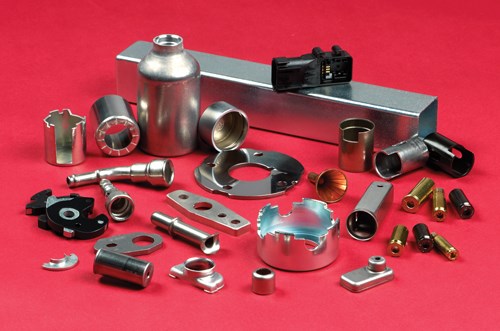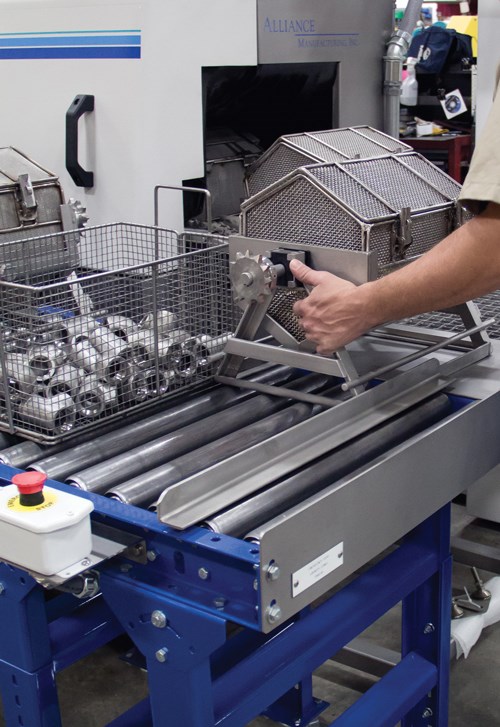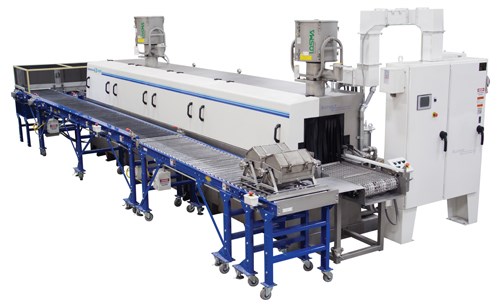The Drive to Meet Strict Cleaning Standards
A high production stamping facility ups its game in process cleaning.
Cleaning is more essential for some manufacturing facilities than others. Some shops clean only select parts that they produce while others clean all of them. Some do superficial cleaning while others must adhere to very strict standards. The types of parts that are produced, the industries they will serve, and how they will be used all play a significant role in their cleaning requirements. Sometimes a company finds that a new cleaning system is necessary to meet the customer’s demands.
Diverse Cleaning for Diverse Parts
Founded in 1946, Jagemann Stamping Co. is a manufacturer of fineblanked, deep-drawn, and progressive stamped metal parts made from aluminum, steel (stainless, cold-rolled, galvannealed, and nickel-plated), and brass and copper. The company produces parts for a variety of industries, primarily in the automotive and industrial markets such as home hardware and electrical components.
At its 200,000-square-foot company headquarters in Manitowoc, Wisconsin, Jagemann runs dozens of transfer, progressive and fine blanking presses, to as much as 700 tons, from companies such as Minster, U.S. Baird, Waterbury Farrel, Platarg, Bliss, Feintool, and Komatsu. The company also has CNC lathes, cylindrical grinding equipment, belt sanders, and rotary finishing machines, as well as pressure testing, automated annealing, automated assembly and inspection, and automated packaging systems. Every part the company produces runs through one of its three large drum washers or one of the four conveyorized belt washers, each configured to meet certain cleanliness specifications.
Mark Pasch, manager, secondary operations, at Jagemann explains that cleaning requirements for the company’s parts can range widely, especially for automotive components. “Some parts might require a dyne test; some might need a millipore test. Some of them are brazed components,” he says. “We need to be careful that we are not mixing different metals, and we have to make sure our steel parts are protected from rust. So the cleaning process we use is highly dependent on the type of part we’re running.”
Because of the company’s extensive cleaning capabilities (and close attention to detail), it typically can manage any final specification the customer can throw its way. Mr. Pasch says many of the company’s fineblanked parts compete with machined components because of the tolerances they can hold. But Jagemann machines a fair amount of parts as well, such as a muffler for automotive air conditioning systems that is produced on Wasino single-spindle and dual-spindle turning centers. The company also has a Wasino dual-spindle machine that runs a brake component for a motorcycle. The turning machines run full-time for three shifts.
Adapting to Changing Requirements
As Jagemann looked to further refine its cleaning processes, one of the main issues it wanted to address was the speed at which parts could be loaded onto the existing belt washers. Loading hundreds of small parts individually, by hand, onto the belt is very time consuming. The large drum washers can often be used for large part quantities, but when using a material that is more susceptible to nicks and dents or when surface finish requirements on a part are particularly tight, these washers might not be a reasonable option. The immediate need was to remove stamping lubricants and other light manufacturing soils from as many as 150,000 parts per day, (variety of part shapes and sizes ranging from 0.03-inch thick by 0.2-inch by 2.5 inch to 0.5-inch thick by 3.25-inch diameter). A strict cleanliness standard of 10 mg/1,000 cm, with no particles larger than 400 micron was required.
The solution the company selected is an Aquamaster CB-1800E indexing, flat-wire conveyor belt washing system from Alliance Manufacturing. This system includes wash, rinse, rust inhibit, and heated blowoff modules. One of the most significant features for Jagemann, though, is the specialized rotating parts basket conveyor system that allows loading of both rotational and non-rotational baskets at any time. “By using baskets, we can prevent nicks and dents on the parts more effectively,” Mr. Pasch says.
Available in a variety of mesh sizes, the rotating baskets are hexagonal in shape and are constructed of stainless steel. They are designed with two perforation sizes to accommodate the varying part sizes. Each basket is removable from a universal carrier, which means that any of the supplied rotational baskets will fit into any carrier. The operator places the baskets into the carrier frame that uses gears to guide rotation via stationary chains on either side of the conveyor belt. Parts that do not need to be tumbled can be loaded into standard baskets that are then placed directly on the conveyor belt. Sensors on the machine temporarily stop the belt to allow the operator to load each basket. As the conveyor moves forward, the baskets are rotated, providing a gentle tumbling of the parts to aid in the cleaning and drying processes.
To move parts in and out of the baskets without causing damage to the parts, the operator uses a hopper with a gate door and avoids dropping the parts more than a specified distance that the parts can withstand. More sensitive parts go in smaller containers. As the baskets tumble in the washer, the basket size limits the distance the parts can fall to an acceptable distance. To minimize loading and unloading, the same baskets are used to transport parts to other operations, such as belt sanding and deburring.
The Aquamaster system is designed specifically for applications requiring high volume cleaning of small components. Each machine can be configured based on the application requirements. Jagemann has elected to include an optional pop-up transfer conveyor with a 180-degree return conveyor to bring the baskets back to the load area of the machine. With this feature, baskets exit the cleaning system and are delivered to the transfer conveyor, which allows baskets to be raised and placed onto a powered roller conveyor to return to the operator. As baskets exit the powered roller conveyor, they are transferred seamlessly to a gravity accumulation conveyor. The length of the gravity conveyor allows several baskets to accumulate. As it reaches capacity, sensors stop the conveyor until excess baskets are removed.
Process Control
Successful cleaning operations are not only dependent on an effective system, but also on proper, efficient use of that system. One factor that helps determine the size of the basket used with a batch of parts is how far those parts will fall during the rotation process and their sensitivity to that fall. Another factor is the complexity of the part. “With a lot of contours in the part, more spray is required to get those parts clean,” Mr. Pasch says. “Those baskets should not contain as many parts.” The rotation of the basket assists in exposing all areas of the parts to a direct spray, but with too many parts loaded on top of each other, no amount of rotation will clear the spray path enough.
The operator can make adjustments to the cleaning process to compensate for more challenging parts—those with complex contours and cavities—by changing the spray pressure for the wash and rinse cycles. Pressures are sometimes as high as 20 pounds for heavier parts, but of course need to be backed off for lighter ones.
The determination of appropriate spray pressures, as well as belt speeds, comes much from previous experience with similar parts. “We might run a few test runs to see what can be improved, but we generally have a solid idea of where to start,” Mr. Pasch says. If the parts aren’t drying well, perhaps there is too much mass, and reducing the number of parts per basket will help. If the parts aren’t clean enough or the rinse isn’t thorough enough, slowing the belt may be the solution. The company does not make adjustments to the chemistry, as a single chemistry has proven to work well across its entire product line.
The cleaning solution chemistry is an important driver of cleaning effectiveness, and Jagemann has partnered with Chemetall to reach its cleaning objectives. For the past year and a half, the surface treatment specialist has been performing audits every couple of weeks to make sure Jagemann’s technicians are titrating the bath correctly and that the temperatures are right. Environmentally, Jagemann is using deionized water in the washers and other products that are phosphorous-free. Chemetall assists in running tests with new products that help to limit outstreaming of oils.
Positive Results
The Aquamaster system has helped Jagemann achieve its next level of cleaning goals. “We brought this unit in to add a wash capability that we did not have, yet needed for the more delicate parts we were taking on,” Mr. Pasch says. The system provides the ability to clean parts without causing handling dings and dents while also not requiring a technician to hand-load onto a belt. The return conveyor makes the system easier to run by alleviating the need for the technician to lift baskets off of the exit end to bring them back for reload. The company can load and unload a basket of parts every minute and a half.
Mr. Pasch concludes by reiterating the significance of process controls to a successful wash operation. The belt speed, spray pressures and quantity of parts per basket must be controlled to ensure predictable cleaning results. The equipment must also be kept clean of built up residue from parts, and the wash and rust inhibit solutions must be properly maintained. With attention to good process control procedures, Jagemann has been able to use the cleaning system to meet its customers’ needs for clean parts.
Related Content
In-line Monitoring for Automated Immersion Cleaning Systems
Ecoclean’s Acoustic Performance Measurement (APM) system provides in-line measurement of ultrasonic frequency and power in fully automated immersion cleaning systems on a batch-by-batch basis or at defined time intervals, such as once a shift, day or week.
Read MoreSita’s CleanoSpector Measures Part Cleanliness
PMTS 2023: Handheld measuring device checks for cleanliness of parts to assure product quality as well as prior to follow-up processes.
Read MoreCool Clean’s Omega 1500 Provides Powerful, Portable Cleaning
PMTS 2023: By selecting the appropriate nozzle and making the necessary propellant pressure and temperature adjustments, the Omega 1500 can clean to a variety of surface cleanliness levels.
Read MoreOvercoming 3 Common Challenges With Automated Particle Counting
Facing difficulties while performing particle analysis is normal but should not be discouraging. Here are some ways to handle the most prevalent issues that can arise.
Read MoreRead Next
5 Aspects of PMTS I Appreciate
The three-day edition of the 2025 Precision Machining Technology Show kicks off at the start of April. I’ll be there, and here are some reasons why.
Read MoreEmerging Leaders Nominations Now Open
Here’s your chance to highlight a young person in your manufacturing business who is on the path to be a future leader moving your company forward.
Read MoreDo You Have Single Points of Failure?
Plans need to be in place before a catastrophic event occurs.
Read More



























